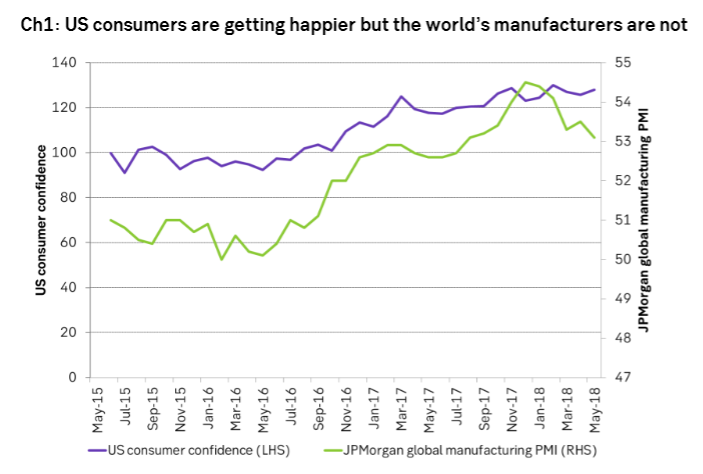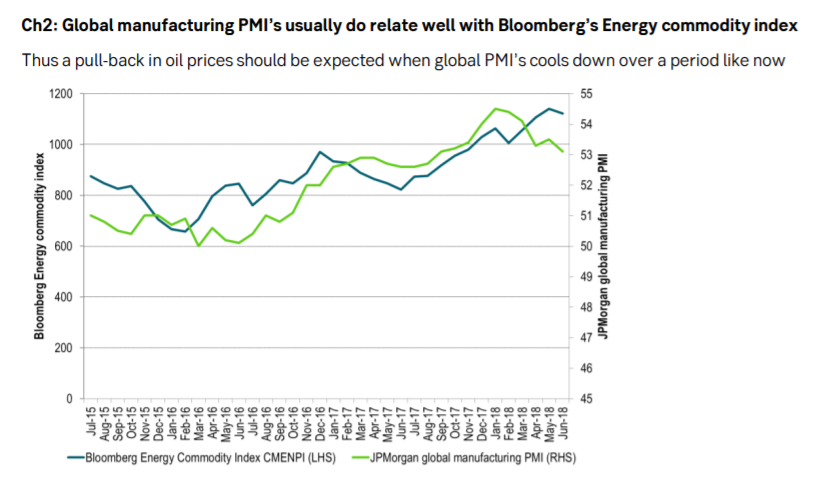Analys
More oil from OPEC+ is the base case

 Saudi Arabia and Russia have already started to lift production and are arguing for an increase in production at the upcoming OPEC+ meeting next week. Unofficial sources have said that Russia will propose to return production back to the October 2016, i.e. removing the cap altogether over a period of three months. The countries who do not have any capacity to increase production are naturally opposing any suggestion of an end to the current cap as they will have no gain from higher production and just face a loss due to a relatively lower price due to production increases by the others. So Iran, Iraq and Venezuela are all opposing any removal of the cap. We think there is no way around an increase in production by Russia and Saudi Arabia. It does not make sense to risk an overly tight oil market in 2H18 just when global economic growth is cooling down with 16 of the world’s largest financial institutions having moved into bear market in a sign that higher interest rates, a stronger USD and higher oil prices are problematic for the global economy. It makes no sense for Saudi Arabia to break the OPEC+ cooperation either as it will likely be needed at another occasion further down the road. The challenge at next week’s OPEC+ meeting will thus be how to formulate a proposal for a gradual revival of production which all members can sign on to.
Saudi Arabia and Russia have already started to lift production and are arguing for an increase in production at the upcoming OPEC+ meeting next week. Unofficial sources have said that Russia will propose to return production back to the October 2016, i.e. removing the cap altogether over a period of three months. The countries who do not have any capacity to increase production are naturally opposing any suggestion of an end to the current cap as they will have no gain from higher production and just face a loss due to a relatively lower price due to production increases by the others. So Iran, Iraq and Venezuela are all opposing any removal of the cap. We think there is no way around an increase in production by Russia and Saudi Arabia. It does not make sense to risk an overly tight oil market in 2H18 just when global economic growth is cooling down with 16 of the world’s largest financial institutions having moved into bear market in a sign that higher interest rates, a stronger USD and higher oil prices are problematic for the global economy. It makes no sense for Saudi Arabia to break the OPEC+ cooperation either as it will likely be needed at another occasion further down the road. The challenge at next week’s OPEC+ meeting will thus be how to formulate a proposal for a gradual revival of production which all members can sign on to.
Price action: Ticking lower with more production from OPEC+ on the horizon
Brent crude fell back 0.8% to $75.88/bl with the longer dated contracts down almost as much as the Dec-2021 contract settled 0.6% lower at $65.94/bl. The WTI benchmark however gained 0.4% to $66.36/bl thus leading to a narrowing of the spread which blew out lately. The Brent to Midland (Permian) WTI spread narrowed to $17.9/bl having recently been trading as wide as $22.0/bl. This morning Brent pulls back another 0.3% to $75.64/bl as production revival by OPEC+ next week seems more and more like the most likely outcome.
OPEC’s MOMR report yesterday contains ammunition for those in OPEC+ who do not want a production revival
OPEC’s monthly oil market report yesterday was somewhat confusing. At the start of the report it highlighted significant uncertainty for Call-on-OPEC for 2H18. It set an uncertainty range of 1.8 m bl/d with a span from 31.5 m bl/d to 33.3 m bl/d and a mean expectation of 32.1 m bl/d. In its supply/demand balance later in the report it still set forecasted a call-on-OPEC at 33.3 m bl/d for 2H18, i.e. at the absolute high end of its uncertainty range highlighted at the start of its report. There must obviously have been some considerable disagreement between different writers participating in the writing of the report. As the report said in the Feature Article “World oil market prospects for the second half of 2018”: “Given the Secretariat’s forecast for 2H18, demand for OPEC crude is projected at 33.3 m bl/d..” Thus the Secretariat seems to have more or less dictated what the official Call-on-OPEC for 2H18 should be thus overruling the analysis that the mean expected call-on-OPEC for 2H18 was projected at 32.1 m bl/d. Or it is basically just two separate pieces of analysis.
OPEC produced 32.1 m bl/d on average from January to May. Thus according to the average forecasted sensitivity analysis in OPEC’s latest MOMR report in the Feature Article there is no room for any increase in production from OPEC in 2H18. Keeping production at current level of about 32.0 would actually keep the market at a neutral balance though OECD. The story in the MOMR Feature Article is thus strong ammunition for all those in the OPEC+ group who are arguing that production should not be lifted from the current production level. Production in Venezuela is of course declining by 50 k bl/d MoM and Iran’s production is likely going to decline a little as well. There is thus obviously some room to increase production by some of the other members in order to compensate for this. The caps set in Nov-2016 are however individual caps so increasing production by Saudi Arabia and Russia in order to compensate for lost supply in Venezuela and possibly Iran needs a vote.
Uncertainty for Call-On-OPEC in 2H18 clearly warrants serious attention. While US consumer confidence is ticking higher the JPMorgan global PMI manufacturing index has ticked lower and lower since its peak in December last year even though it is still in positive territory of 53.1. Global growth has definitely cooled in 1H18. At the moment it does not seems as if a booming US economy is able to drag the rest of the world with it. Rather it seems like higher interest rates, a stronger USD and a higher oil price increasingly is creating a headwind for the global economy. The story in the FT today that 16 large global financial companies are down more than 20% from their peaks is highlighting the fact that the global economy is having a problem swallowing higher interest rates, stronger dollar and more expensive oil.
We expect OPEC+ to decide next week to increase production by 0.5 m bl/d in 2H18 at a gradual and measured pace.
Ch3: Solid OECD inventory decline in April if adjusting for normal seasonal trendsThe OECD inventories declined
MoM by 3.1 million barrels in April. However, inventories normally rise by 26 million barrels in April. So versus seasonal trends the OECD inventories fell 28.6 million barrels in April which is equal to a seasonally adjusted deficit of 0.95 m bl/d.
Analys
Crude stocks fall again – diesel tightness persists

U.S. commercial crude inventories posted another draw last week, falling by 2.4 million barrels to 418.3 million barrels, according to the latest DOE report. Inventories are now 6% below the five-year seasonal average, underlining a persistently tight supply picture as we move into the post-peak demand season.

While the draw was smaller than last week’s 6 million barrel decline, the trend remains consistent with seasonal patterns. Current inventories are still well below the 2015–2022 average of around 449 million barrels.
Gasoline inventories dropped by 1.2 million barrels and are now close to the five-year average. The breakdown showed a modest increase in finished gasoline offset by a decline in blending components – hinting at steady end-user demand.
Diesel inventories saw yet another sharp move, falling by 1.8 million barrels. Stocks are now 15% below the five-year average, pointing to sustained tightness in middle distillates. In fact, diesel remains the most undersupplied segment, with current inventory levels at the very low end of the historical range (see page 3 attached).
Total commercial petroleum inventories – including crude and products but excluding the SPR – fell by 4.4 million barrels on the week, bringing total inventories to approximately 1,259 million barrels. Despite rising refinery utilization at 94.6%, the broader inventory complex remains structurally tight.
On the demand side, the DOE’s ‘products supplied’ metric – a proxy for implied consumption – stayed strong. Total product demand averaged 21.2 million barrels per day over the last four weeks, up 2.5% YoY. Diesel and jet fuel were the standouts, up 7.7% and 1.7%, respectively, while gasoline demand softened slightly, down 1.1% YoY. The figures reflect a still-solid late-summer demand environment, particularly in industrial and freight-related sectors.


Analys
Increasing risk that OPEC+ will unwind the last 1.65 mb/d of cuts when they meet on 7 September

Pushed higher by falling US inventories and positive Jackson Hall signals. Brent crude traded up 2.9% last week to a close of $67.73/b. It traded between $65.3/b and $68.0/b with the low early in the week and the high on Friday. US oil inventory draws together with positive signals from Powel at Jackson Hall signaling that rate cuts are highly likely helped to drive both oil and equities higher.

Ticking higher for a fourth day in a row. Bank holiday in the UK calls for muted European session. Brent crude is inching 0.2% higher this morning to $67.9/b which if it holds will be the fourth trading day in a row with gains. Price action in the European session will likely be quite muted due to bank holiday in the UK today.
OPEC+ is lifting production but we keep waiting for the surplus to show up. The rapid unwinding of voluntary cuts by OPEC+ has placed the market in a waiting position. Waiting for the surplus to emerge and materialize. Waiting for OECD stocks to rise rapidly and visibly. Waiting for US crude and product stocks to rise. Waiting for crude oil forward curves to bend into proper contango. Waiting for increasing supply of medium sour crude from OPEC+ to push sour cracks lower and to push Mid-East sour crudes to increasing discounts to light sweet Brent crude. In anticipation of this the market has traded Brent and WTI crude benchmarks up to $10/b lower than what solely looking at present OECD inventories, US inventories and front-end backwardation would have warranted.
Quite a few pockets of strength. Dubai sour crude is trading at a premium to Brent crude! The front-end of the crude oil curves are still in backwardation. High sulfur fuel oil in ARA has weakened from parity with Brent crude in May, but is still only trading at a discount of $5.6/b to Brent versus a more normal discount of $10/b. ARA middle distillates are trading at a premium of $25/b versus Brent crude versus a more normal $15-20/b. US crude stocks are at the lowest seasonal level since 2018. And lastly, the Dubai sour crude marker is trading a premium to Brent crude (light sweet crude in Europe) as highlighted by Bloomberg this morning. Dubai is normally at a discount to Brent. With more medium sour crude from OPEC+ in general and the Middle East specifically, the widespread and natural expectation has been that Dubai should trade at an increasing discount to Brent. the opposite has happened. Dubai traded at a discount of $2.3/b to Brent in early June. Dubai has since then been on a steady strengthening path versus Brent crude and Dubai is today trading at a premium of $1.3/b. Quite unusual in general but especially so now that OPEC+ is supposed to produce more.
This makes the upcoming OPEC+ meeting on 7 September even more of a thrill. At stake is the next and last layer of 1.65 mb/d of voluntary cuts to unwind. The market described above shows pockets of strength blinking here and there. This clearly increases the chance that OPEC+ decides to unwind the remaining 1.65 mb/d of voluntary cuts when they meet on 7 September to discuss production in October. Though maybe they split it over two or three months of unwind. After that the group can start again with a clean slate and discuss OPEC+ wide cuts rather than voluntary cuts by a sub-group. That paves the way for OPEC+ wide cuts into Q1-26 where a large surplus is projected unless the group kicks in with cuts.
The Dubai medium sour crude oil marker usually trades at a discount to Brent crude. More oil from the Middle East as they unwind cuts should make that discount to Brent crude even more pronounced. Dubai has instead traded steadily stronger versus Brent since late May.
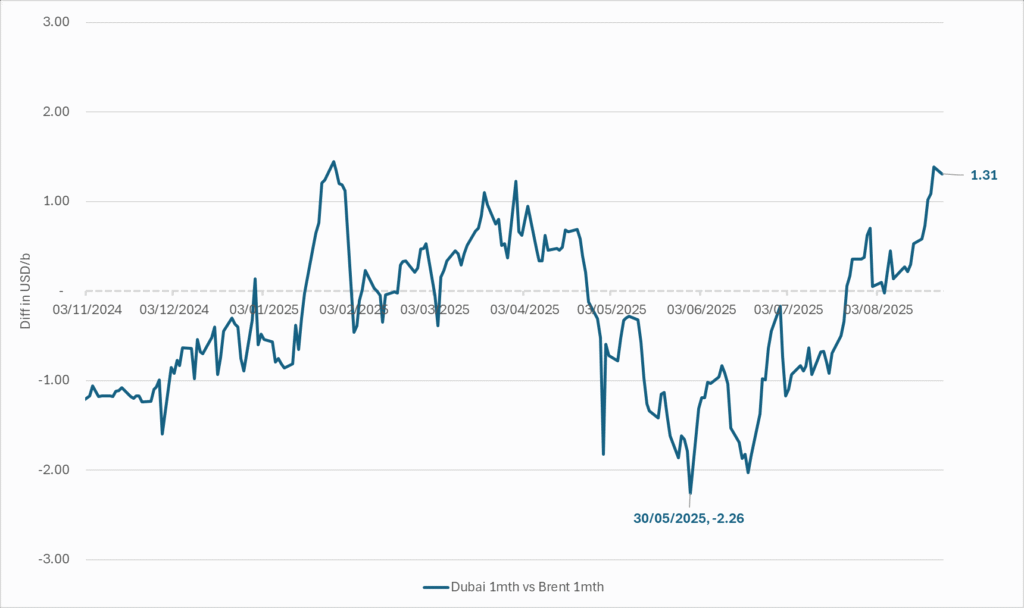
The Brent crude oil forward curve (latest in white) keeps stuck in backwardation at the front end of the curve. I.e. it is still a tight crude oil market at present. The smile-effect is the market anticipation of surplus down the road.
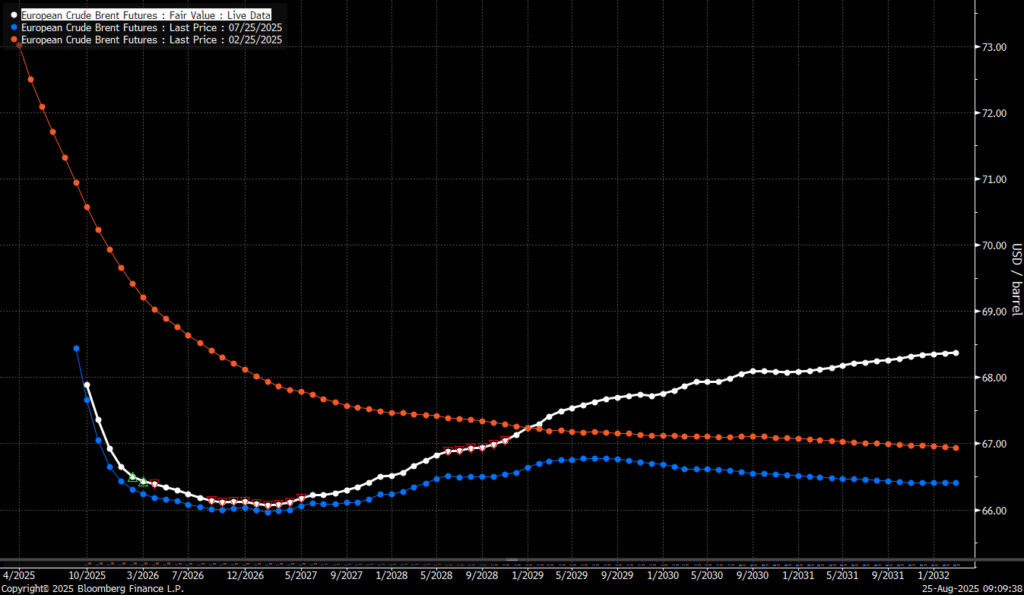
Analys
Brent edges higher as India–Russia oil trade draws U.S. ire and Powell takes the stage at Jackson Hole

Best price since early August. Brent crude gained 1.2% yesterday to settle at USD 67.67/b, the highest close since early August and the second day of gains. Prices traded to an intraday low of USD 66.74/b before closing up on the day. This morning Brent is ticking slightly higher at USD 67.76/b as the market steadies ahead of Fed Chair Jerome Powell’s Jackson Hole speech later today.

No Russia/Ukraine peace in sight and India getting heat from US over imports of Russian oil. Yesterday’s price action was driven by renewed geopolitical tension and steady underlying demand. Stalled ceasefire talks between Russia and Ukraine helped maintain a modest risk premium, while the spotlight turned to India’s continued imports of Russian crude. Trump sharply criticized New Delhi’s purchases, threatening higher tariffs and possible sanctions. His administration has already announced tariff hikes on Indian goods from 25% to 50% later this month. India has pushed back, defending its right to diversify crude sourcing and highlighting that it also buys oil from the U.S. Moscow meanwhile reaffirmed its commitment to supply India, deepening the impression that global energy flows are becoming increasingly politicized.
Holding steady this morning awaiting Powell’s address at Jackson Hall. This morning the main market focus is Powell’s address at Jackson Hole. It is set to be the key event for markets today, with traders parsing every word for signals on the Fed’s policy path. A September rate cut is still the base case but the odds have slipped from almost certainty earlier this month to around three-quarters. Sticky inflation data have tempered expectations, raising the stakes for Powell to strike the right balance between growth concerns and inflation risks. His tone will shape global risk sentiment into the weekend and will be closely watched for implications on the oil demand outlook.
For now, oil is holding steady with geopolitical frictions lending support and macro uncertainty keeping gains in check.
Oil market is starting to think and worry about next OPEC+ meeting on 7 September. While still a good two weeks to go, the next OPEC+ meeting on 7 September will be crucial for the oil market. After approving hefty production hikes in August and September, the question is now whether the group will also unwind the remaining 1.65 million bpd of voluntary cuts. Thereby completing the full phase-out of voluntary reductions well ahead of schedule. The decision will test OPEC+’s balancing act between volume-driven influence and price stability. The gathering on 7 September may give the clearest signal yet of whether the group will pause, pivot, or press ahead.
-

 Nyheter3 veckor sedan
Nyheter3 veckor sedanOmgående mångmiljardfiasko för Equinors satsning på Ørsted och vindkraft
-
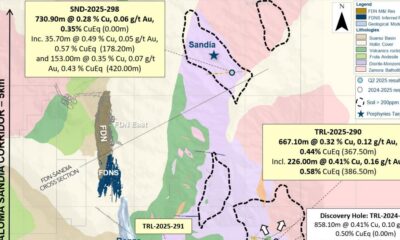
 Nyheter4 veckor sedan
Nyheter4 veckor sedanLundin Gold hittar ny koppar-guld-fyndighet vid Fruta del Norte-gruvan
-

 Nyheter1 vecka sedan
Nyheter1 vecka sedanMeta bygger ett AI-datacenter på 5 GW och 2,25 GW gaskraftverk
-

 Nyheter3 veckor sedan
Nyheter3 veckor sedanGuld stiger till över 3500 USD på osäkerhet i världen
-

 Analys3 veckor sedan
Analys3 veckor sedanWhat OPEC+ is doing, what it is saying and what we are hearing
-

 Nyheter4 veckor sedan
Nyheter4 veckor sedanAlkane Resources och Mandalay Resources har gått samman, aktör inom guld och antimon
-

 Nyheter2 veckor sedan
Nyheter2 veckor sedanAker BP gör ett av Norges största oljefynd på ett decennium, stärker resurserna i Yggdrasilområdet
-

 Nyheter4 veckor sedan
Nyheter4 veckor sedanLyten, tillverkare av litium-svavelbatterier, tar över Northvolts tillgångar i Sverige och Tyskland



